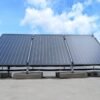Common Solar Power Ratings.
COMMON APPLIANCE POWER RATINGS & ABBREVIATIONS.
Common Solar Power Ratings. When setting up a solar power system—whether for a home, office, or business—understanding common solar power ratings is essential. These ratings help you determine how much power your system can generate, store, and deliver to your appliances.
Solar power systems are made up of different components like solar panels, inverters, batteries, and charge controllers—each with its own set of ratings. These include measurements like watts (W), kilowatts (kW), ampere-hours (Ah), and volts (V). These values guide you in sizing your system correctly so you don’t over- or under-invest.
Whether you’re planning an off-grid solar system or a grid-tied solution, knowing what these ratings mean will help you make better choices for cost, efficiency, and reliability.
W (Watt):
This is the basic unit of power. It tells you how much electricity an appliance consumes at a given moment. For example, a 60W light bulb uses 60 watts of power when turned on.
kW (Kilowatt):
A kilowatt is equal to 1,000 watts. It’s used to express the power consumption of larger appliances, such as electric water heaters or industrial machines. For example, a 2kW electric heater consumes 2,000 watts.
VA (Volt-Ampere):
This represents apparent power and is used mainly in sizing UPS systems and inverters. It’s the product of voltage and current (V × A), without correcting for power factor. Some appliances list both watts and VA.
kVA (Kilovolt-Ampere):
This is 1,000 volt-amperes. It’s commonly used in generator, transformer, and inverter sizing. It reflects total power supplied, including inefficiencies due to power factor.
Wh (Watt-hour):
This measures energy consumed over time. If you run a 100W bulb for 1 hour, it uses 100Wh. If it runs for 5 hours, it consumes 500Wh.
kWh (Kilowatt-hour):
This is 1,000 watt-hours and is the unit electricity companies use for billing. For instance, if you use ten 100W bulbs for 10 hours, you’ll consume 1kWh (1 unit of electricity).
V (Volt):
This measures electrical potential. Most solar systems operate in 12V, 24V, or 48V configurations, while household mains voltage in Kenya is typically 230V AC.
Megawatt (MW)
1,000,000 watts; used for industrial or utility-scale solar farms.
Watt-hour (Wh)
A unit of energy representing power consumption over time (e.g., a 100W device running for 1 hour uses 100Wh).
Kilowatt-hour (kWh)
1,000 watt-hours; the standard unit for electricity billing (e.g., a 3kWh battery can power a 300W load for 10 hours).
Ampere (A)
A measure of electric current; determines wire thickness and fuse ratings.
Volt (V)
A measure of electrical potential difference; common solar systems use 12V, 24V, or 48V.
Volt-Ampere (VA)
Apparent power in an AC circuit (real power is measured in watts).
Kilovolt-Ampere (kVA)
1,000 VA; used for inverters and generators (e.g., a 5kVA inverter can handle 5,000 VA of load).
Power Factor (PF)
The ratio of real power (W) to apparent power (VA); typically 0.8–1.0 for solar systems.
Efficiency (%)
The percentage of sunlight converted into usable electricity (e.g., a 20% efficient solar panel converts 20% of sunlight into power).
Peak Sun Hours (PSH)
The equivalent hours of full sunlight a location receives (Kenya averages 4–6 PSH).
Solar Irradiance (W/m²)
The power per unit area received from the sun (standard test condition is 1,000 W/m²).
Temperature Coefficient (%/°C)
How much a solar panel’s efficiency drops as temperature rises (e.g., -0.4%/°C means efficiency decreases by 0.4% per degree above 25°C).
Nominal Voltage
The standard reference voltage of a battery or solar system (e.g., 12V, 24V, 48V).
Operating Voltage
The actual voltage range a solar appliance works within (e.g., a 12V solar pump may operate between 10V–18V).
Open-Circuit Voltage (Voc)
The maximum voltage a solar panel produces when not connected to a load.
Short-Circuit Current (Isc)
The maximum current a solar panel produces when its terminals are shorted.
Maximum Power Point (MPP)
The optimal voltage and current where a solar panel produces maximum power.
MPPT (Maximum Power Point Tracking)
A technology in charge controllers that maximizes solar panel efficiency.
PWM (Pulse Width Modulation)
A simpler, cheaper charge controller method compared to MPPT.
Depth of Discharge (DoD)
The percentage of a battery’s capacity that has been used (e.g., 50% DoD means only half the battery is drained).
State of Charge (SoC)
The remaining battery capacity as a percentage (e.g., 80% SoC means 80% charge left).
Cycle Life
The number of charge-discharge cycles a battery can handle before capacity drops (e.g., 1,000 cycles at 50% DoD).
C-Rating
A battery’s charge/discharge rate relative to its capacity (e.g., 1C means full discharge in 1 hour).
Ah (Ampere-hour)
A battery’s capacity; a 100Ah battery can supply 5A for 20 hours (at 20-hour rate).
Energy Density (Wh/kg)
How much energy a battery stores per unit weight (lithium-ion has higher density than lead-acid).
Round-Trip Efficiency (%)
The percentage of energy retained when charging and discharging a battery (e.g., 90% means 10% is lost).
Inverter Efficiency (%)
How efficiently an inverter converts DC to AC (typically 90–98%).
Surge Power (W or VA)
The temporary high power an inverter can handle for motor startups (e.g., 3,000W surge for a 1,000W inverter).
Continuous Power (W or VA)
The sustained power an inverter can deliver (e.g., 1,000W continuous).
THD (Total Harmonic Distortion)
The level of electrical noise an inverter produces (lower is better, <5% is ideal).
UPS (Uninterruptible Power Supply)
A backup power system that switches instantly during outages.
Off-Grid Inverter
An inverter designed for standalone solar systems without grid connection.
On-Grid (Grid-Tied) Inverter
An inverter that synchronizes with the utility grid (no battery backup).
Hybrid Inverter
Combines solar, battery, and grid power for flexible energy use.
Microinverter
A small inverter attached to each solar panel for individual optimization.
String Inverter
A central inverter that connects multiple solar panels in series.
Battery Voltage (12V, 24V, 48V)
The nominal voltage of a solar battery bank.
Battery Bank
Multiple batteries connected to increase capacity or voltage.
Series Connection
Batteries or panels connected to increase voltage (e.g., two 12V batteries in series = 24V).
Parallel Connection
Batteries or panels connected to increase capacity (e.g., two 100Ah batteries in parallel = 200Ah at same voltage).
Charge Rate (C-rate)
How fast a battery charges relative to its capacity (e.g., 0.5C means charging a 100Ah battery at 50A).
Float Voltage
The maintenance voltage for keeping a battery fully charged without overcharging.
Equalization Charge
A controlled overcharge to balance battery cells in lead-acid systems.
Solar Panel Wattage (Wp)
The rated power of a solar panel under standard test conditions (e.g., 300Wp).
Panel Efficiency (%)
The percentage of sunlight converted into electricity (monocrystalline: 18–22%).
Bypass Diode
Prevents power loss in solar panels when shaded.
Frame Type (Anodized Aluminum)
The material used for solar panel frames (aluminum is standard).
Tolerance (%)
The allowed power variation in a solar panel (e.g., +5% means a 300W panel can produce up to 315W).
NOCT (Nominal Operating Cell Temperature)
The expected temperature of a solar panel under real-world conditions (typically 45°C).
Fire Rating (Class A, B, C)
How resistant solar panels are to fire hazards (Class A is best).
Wind Load Rating (Pa or mph)
The maximum wind speed a solar mounting system can withstand.
Snow Load Rating (Pa or kg/m²)
The weight of snow a solar panel can handle (relevant in colder climates).
IP Rating (Ingress Protection)
A device’s resistance to dust and water (e.g., IP65 means dust-tight and water-resistant).
NEMA Rating
A standard for electrical enclosure protection (e.g., NEMA 4X is weatherproof).
UL Certification
A safety certification for solar equipment (common in the U.S.).
IEC Certification
International standards for solar panel performance and safety.
TUV Certification
A German safety and quality standard for solar products.
CE Marking
Indicates compliance with European safety standards.
Kenya Bureau of Standards (KEBS)
Certifies solar products for use in Kenya.
Energy Star Rating
A certification for energy-efficient appliances.
Inrush Current
The temporary high current when a motor starts (affects inverter sizing).
Standby Power (W)
The power consumed by an inverter when idle (should be low).
MPPT Voltage Range
The input voltage range an MPPT charge controller can handle (e.g., 30–150V).
PWM Voltage Range
The input voltage range for PWM controllers (must match battery voltage).
Battery Type (Li-ion, Lead-Acid, Gel, AGM)
Different battery chemistries with varying lifespans and costs.
AGM (Absorbent Glass Mat) Battery
A sealed lead-acid battery with high discharge rates.
Gel Battery
A lead-acid battery with gel electrolyte, good for deep cycles.
Lithium Iron Phosphate (LiFePO4)
A long-life, lightweight lithium battery chemistry.
Nickel-Cadmium (NiCd) Battery
Rare in solar, used in extreme temperatures.
Flow Battery
A large-scale battery technology for solar storage.
Self-Discharge Rate (% per month)
How much a battery loses charge when unused (lithium: 1–3%, lead-acid: 5–10%).
BMS (Battery Management System)
Protects lithium batteries from overcharge, over-discharge, and overheating.
SOC (State of Health)
A battery’s remaining capacity compared to its original capacity.
Solar Water Heater Collector Type (Flat Plate, Evacuated Tube)
Different technologies for capturing solar heat.
Collector Efficiency (%)
How well a solar water heater converts sunlight into heat.
Storage Tank Capacity (Liters)
The volume of hot water a solar heater can store (e.g., 200L).
Heat Loss Coefficient (W/m²K)
How well a solar water heater retains heat.
Solar Pump Head (Meters)
The maximum height a solar water pump can lift water.
Solar Pump Flow Rate (Liters per Hour, LPH)
How much water a solar pump can move (e.g., 1,500 LPH).
DC Solar Pump
A pump running directly on solar power (no inverter needed).
AC Solar Pump
A pump requiring an inverter to convert DC to AC.
Submersible Solar Pump
A pump designed to operate underwater in boreholes.
Surface Solar Pump
A pump installed above ground for rivers or tanks.
Solar Street Light Lumens (lm)
The brightness of a solar-powered light (e.g., 3,000 lumens).
LED Wattage (W)
The power consumption of the light (e.g., 30W LED).
Battery Backup (Hours)
How long a solar light operates without sunlight (e.g., 12 hours).
Motion Sensor
A feature in solar lights that activates when movement is detected.
Dusk-to-Dawn Operation
A solar light that automatically turns on at night and off at sunrise.
Solar Charge Time (Hours)
How long a solar device takes to fully charge (e.g., 6–8 hours).
Operating Temperature Range (°C)
The minimum and temperatures a solar device can handle (e.g., -20°C to 60°C).
Warranty (Years)
The guaranteed lifespan of a solar product (e.g., 25 years for panels, 5 years for inverters).
Degradation Rate (% per year)
How much a solar panel’s output declines annually (e.g., 0.5%).
PID-Free Solar Panels
Panels resistant to potential-induced degradation.
Anti-Reflective Coating
A solar panel feature that reduces sunlight reflection, increasing efficiency.
Bifacial Solar Panels
Panels that capture sunlight on both sides for higher output.
Solar Tracker
A system that tilts panels to follow the sun’s path.
Single-Axis Tracker
A solar tracker that moves panels along one direction (east-west).
Dual-Axis Tracker
A tracker that adjusts panels in both azimuth and elevation for maximum sun exposure.
Load Shedding Mode
A feature in hybrid inverters that prioritizes solar/battery during grid outages.
Net Metering Capacity (kW)
The maximum solar system size allowed for grid-tied net metering.
Feed-in Tariff Rate (KES/kWh)
The payment rate for excess solar power fed into the grid.
Solar Leasing Rate (KES/month)
The monthly cost for leasing a solar system instead of buying.
Payback Period (Years)
The time it takes for solar savings to cover installation costs (e.g., 4–7 years in Kenya).
LCOE (Levelized Cost of Energy, KES/kWh)
The average cost of solar power over a system’s lifetime.
Solar ROI (Return on Investment, %)
The financial return from a solar system compared to its cost.
O&M Cost (KES/year)
Annual operations and maintenance expenses for a solar system.
Solar Insurance
Coverage for solar systems against damage or theft.
Performance Ratio (PR, %)
The actual output of a solar system compared to its theoretical maximum.
Solar Yield (kWh/kWp/year)
The annual energy production per kW of installed solar capacity.
Shading Loss (%)
The reduction in solar output due to shadows (e.g., 10% loss from a tree).
Soiling Loss (%)
The energy loss due to dust or dirt on solar panels (e.g., 5% in dusty areas).
Clipping Loss (%)
The power lost when solar production exceeds inverter capacity.
Transformer Loss (%)
Energy lost in voltage conversion (relevant for large solar farms).
Solar Cable Size (mm²)
The cross-sectional area of solar wiring (e.g., 4mm² for 10A current).
DC Isolator
A safety switch for disconnecting solar panels.
AC Disconnect
A switch for isolating the inverter from the grid.
Grounding (Earthing)
A safety measure to prevent electrical shocks in solar systems.
Lightning Arrestor
Protects solar systems from lightning strikes.
Surge Protector
Shields solar electronics from voltage spikes.
Arc Fault Detection
A safety feature in solar inverters to prevent fires.
Rapid Shutdown
A safety mechanism to de-energize solar panels during emergencies.
Remote Monitoring
Tracking solar system performance via apps or online portals.
SCADA System
Advanced monitoring for large-scale solar plants.
Solar API Integration
Connecting solar data to smart home systems.
Time-of-Use (TOU) Optimization
Adjusting solar usage to match peak/off-peak electricity rates.
Peak Shaving
Using solar/battery to reduce grid power during high-demand periods.
Solar Diesel Hybrid
Combining solar with diesel generators for backup.
Solar Wind Hybrid
A system integrating solar and wind power.
Solar Hydro Hybrid
Combining solar with hydropower for 24/7 energy.
Solar Biomass Hybrid
Using solar with biomass generators for rural electrification.
Solar Mini-Grid Voltage (230V, 400V)
The distribution voltage in community solar grids.
Solar Nano-Grid (12V, 24V, 48V)
Small-scale solar grids for villages or small businesses.
Solar PAYG (Pay-As-You-Go)
A financing model where users pay for solar in installments.
Solar Mobile Money Payments
Using M-Pesa or Airtel Money for solar energy payments.
Solar Cloud Monitoring
Storing solar performance data on remote servers.
Solar AI Optimization
Using artificial intelligence to maximize solar efficiency.
Solar Blockchain
Decentralized energy trading using blockchain technology.
Solar IoT (Internet of Things)
Smart solar devices connected for automated control.
Solar Edge Computing
Processing solar data locally for faster response times.
Solar Virtual Power Plant (VPP)
Linking multiple solar systems to act as a single power source.
Solar Carbon Credits
Earning credits by offsetting fossil fuel use with solar.
Solar ESG Compliance
Meeting environmental, social, and governance standards.
Solar Green Bonds
Investments funding large-scale solar projects.
Solar Impact Investing
Funding solar projects for both profit and social good.
Solar Microfinance
Small loans for solar systems in low-income areas.
Solar Crowdfunding
Community-funded solar projects.
Solar Energy Cooperatives
Member-owned solar power initiatives.
Solar PPAs in Kenya
Power Purchase Agreements for commercial solar projects.
Solar EPC Contracts
Engineering, Procurement, and Construction agreements for solar installations.
Solar O&M Contracts
Long-term maintenance agreements for solar systems.
Solar Performance Guarantee
A warranty ensuring a solar system meets output promises.
Solar Asset Management
Professional management of solar investments.
Solar Insurance Products
Policies covering solar equipment and revenue loss.
Solar RECs (Renewable Energy Certificates)
Tradable certificates proving solar energy generation.
Solar Net Zero Building
A structure powered entirely by solar energy.
Solar-Powered EV Charging
Using solar energy to charge electric vehicles.
Solar-Powered Desalination
Converting seawater to freshwater using solar energy.
Solar-Powered Agriculture
Using solar for irrigation, cooling, and processing.
Solar-Powered Healthcare
Solar energy for clinics, vaccine storage, and medical devices.
Solar-Powered Education
Solar energy for schools and e-learning centers.
Solar-Powered E-Mobility
Solar-charged electric bikes, tuk-tuks, and buses.
Solar-Powered 5G Towers
Telecom towers running on solar energy.
Solar-Powered Data Centers
Renewable energy for cloud computing infrastructure.
Solar-Powered Bitcoin Mining
Using solar to power cryptocurrency operations.
Solar-Powered AI Data Farms
Sustainable energy for artificial intelligence processing.
Solar-Powered Smart Cities
Urban areas integrating solar into infrastructure.
Solar-Powered Vertical Farms
Indoor agriculture using solar energy.
Solar-Powered Hydrogen Production
Using solar to generate green hydrogen fuel.
Solar-Powered Carbon Capture
Renewable energy for removing CO₂ from the atmosphere.
Solar-Powered Space Exploration
Solar energy for satellites and Mars missions.
Solar-Powered Future Cities
A vision of fully solar-sustained urban living.



